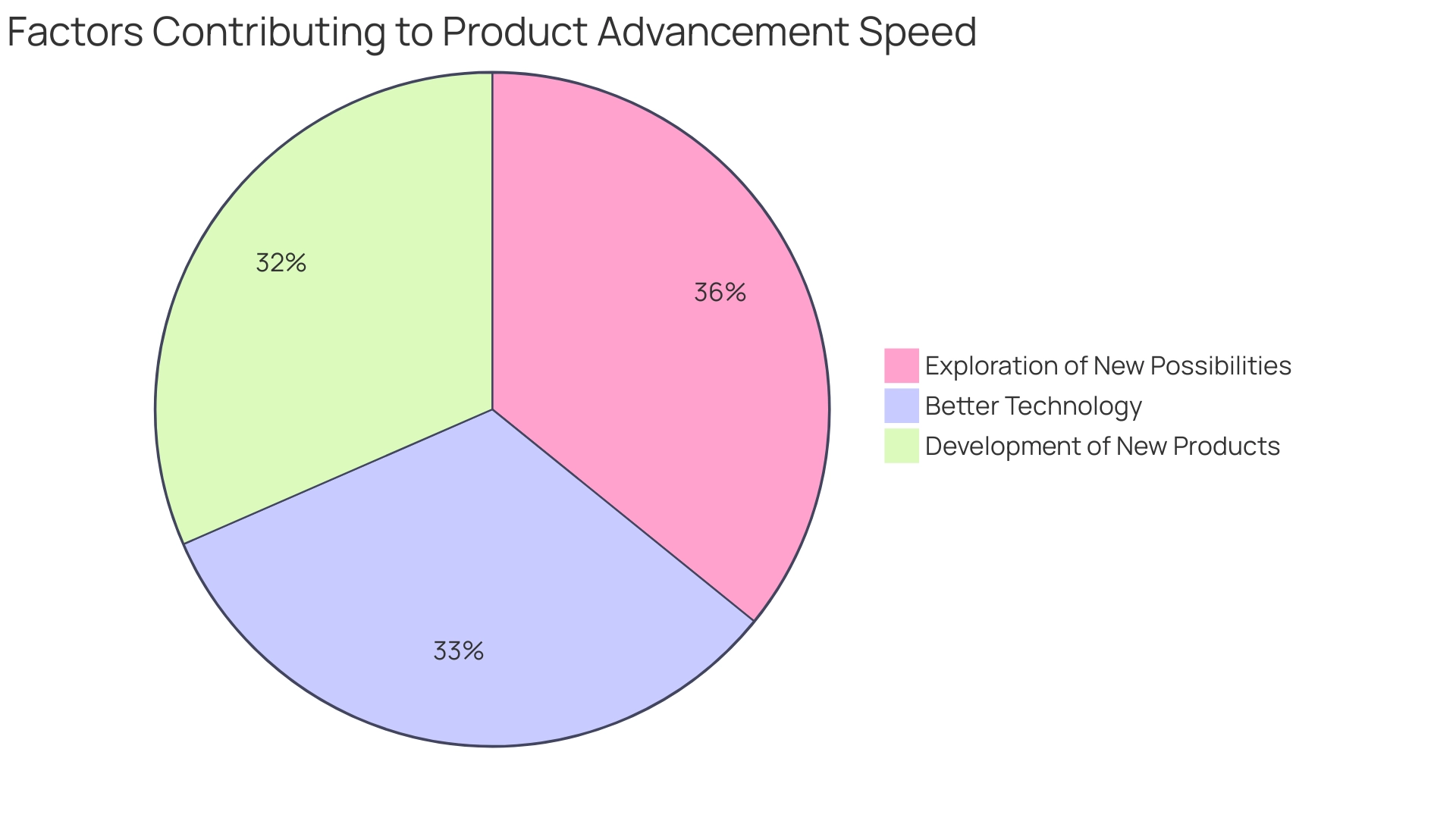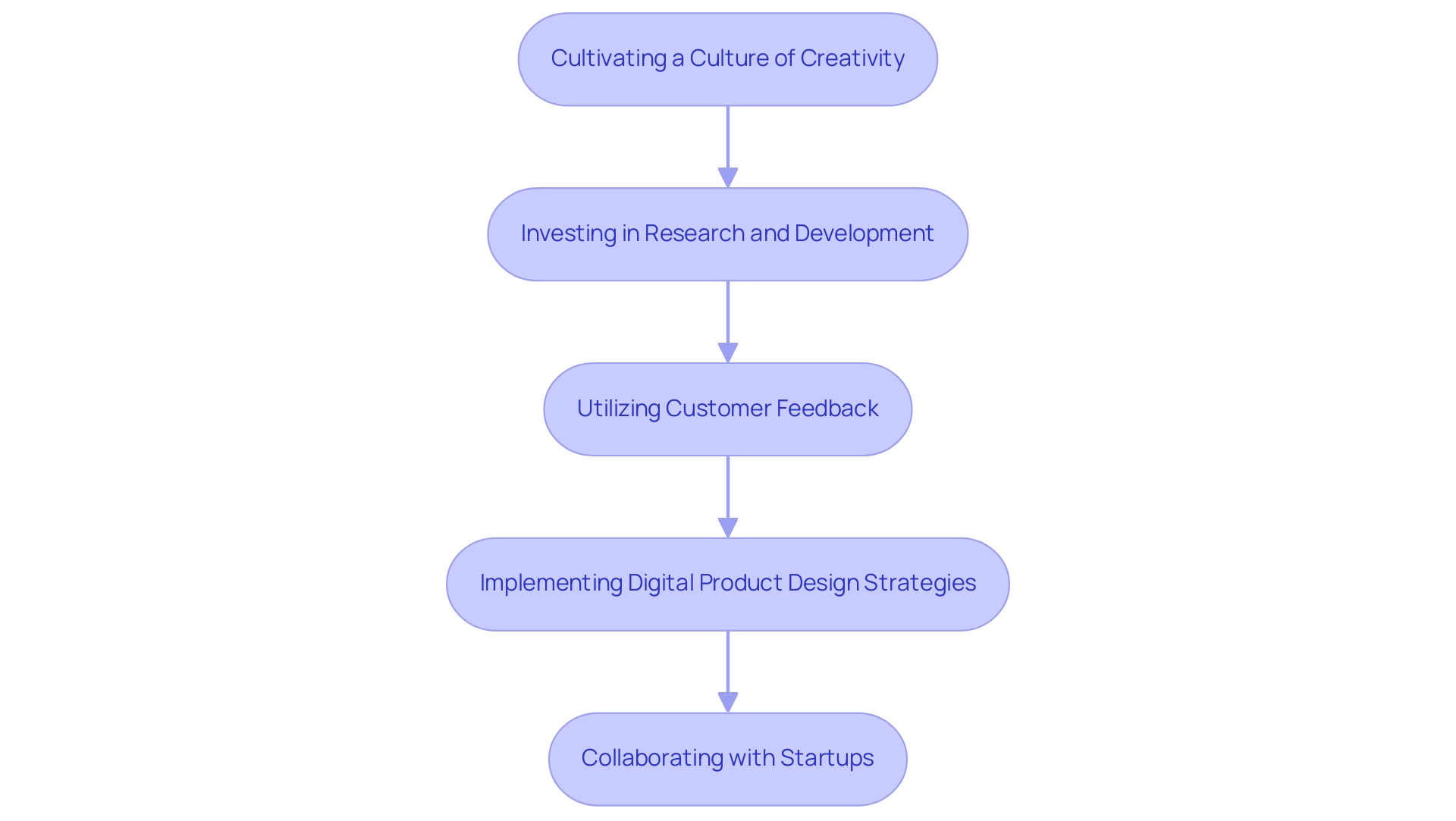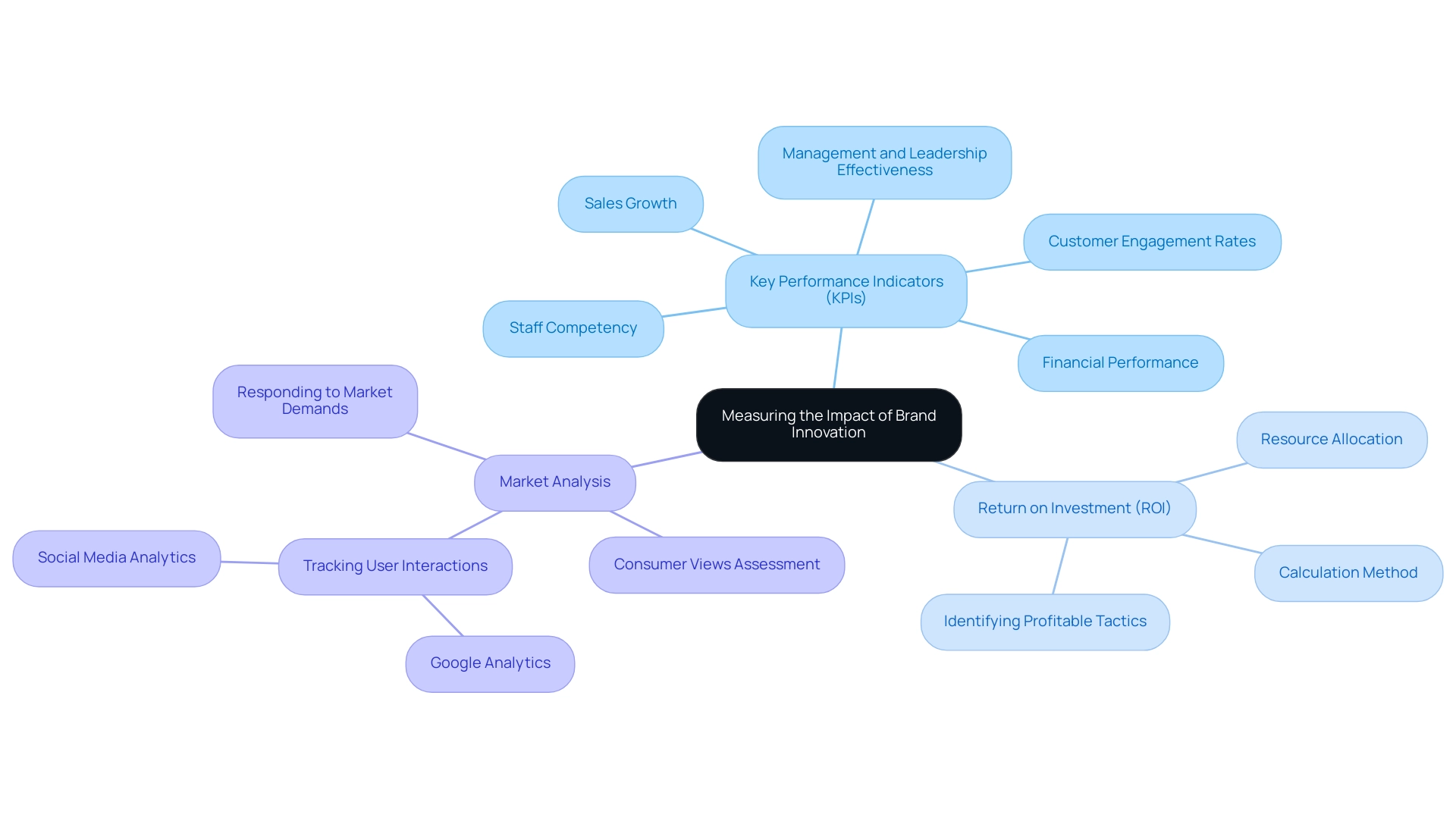Overview
The article discusses best practices for brand innovation, emphasizing the importance of creativity, customer engagement, and sustainability as key drivers for success in a competitive market. It supports this by illustrating proven strategies such as fostering a culture of creativity, investing in research and development, leveraging technology for insights, and prioritizing sustainability, all of which enhance brand value and consumer loyalty.
Introduction
In an era where consumer preferences are shifting at an unprecedented pace, brand innovation emerges as a critical factor for success in the marketplace.
As businesses strive to maintain relevance and competitive advantage, the ability to adapt and evolve becomes paramount.
This article delves into the multifaceted nature of brand innovation, exploring its significance in fostering customer loyalty and driving growth.
With compelling case studies and insights from industry leaders, it highlights the strategies that empower brands to not only meet but anticipate the needs of their audiences.
From leveraging technology and sustainability to engaging customers through personalized experiences, the exploration of brand innovation reveals how companies can thrive in today's dynamic landscape.
Understanding Brand Innovation: A Key to Market Success
The advancement of a brand, which brands innovation, includes the creation of new concepts, products, or services intended to enhance a company's value and significance in a progressively changing market. As consumer preferences change quickly, it is essential for companies to adopt new ideas to maintain their competitive advantage. serves as a prime example of empowering modern founders for digital success, showcasing how a strong identity can adapt and thrive.
Recent findings indicate that through increased purchasing behavior, underscoring the significance of . '71% of UK consumers demonstrate their trust in a company by making more purchases,' states Adobe (2024), emphasizing that a strong connection can significantly influence consumer behavior. Firms such as Apple and Tesla illustrate this principle; their steadfast dedication to creativity resonates with their clientele and fosters lasting loyalty.
This strategic focus on innovation enables while retaining existing ones by consistently addressing their evolving needs and expectations. Additionally, is demonstrated in the case study with Cirkul, which showcases . Insights from RNO1's W3W™ Podcast Episode #2 also shed light on for positioning in a competitive landscape.
Furthermore, a case study titled 'Leading Causes of Increased Advancement Speed' reveals that :
- Exploration of new possibilities (67%)
- Better technology (61%)
- Development of new products (59%)
This emphasizes the diverse factors behind product advancement. Furthermore, data indicates that posts with images produce 650% greater engagement compared to text-only posts, highlighting the effectiveness of innovative marketing approaches.
Highlighting product advancement is not just a choice; it is an essential requirement for any label aiming to succeed in today's competitive environment, as brands innovation through effective marketing efforts enhances product perception and offers a lasting competitive edge. Insights from , providing valuable perspectives on branding advancement and digital growth approaches.

Proven Strategies for Driving Brand Innovation
To effectively drive in today’s agile market, companies should adopt several key approaches:
- is paramount. This can be achieved by encouraging team brainstorming sessions and fostering open communication, which lays the groundwork for brands innovation. Interpersonal relationships in the workplace significantly influence brands innovation, as collaboration often sparks new ideas and perspectives.
- Committing to is essential for exploring new ideas and technologies that can drive brands innovation forward. , functional prototyping, and UX/UI design exemplifies this commitment, driving . Establishing collaborations with external partners, such as startups and academic institutions, brands innovation by inviting fresh perspectives and innovative solutions.
- Actively utilizing customer feedback not only guides brands innovation efforts but also ensures new developments resonate with consumer needs. A case in point is Spotify, which continuously adapts its platform based on user insights, allowing it to maintain a competitive edge in the dynamic music streaming industry. Additionally, with 71% of respondents recognizing the , it is crucial for companies to stay ahead of these trends to remain relevant.
- Companies like RNO1 utilize , including , to enhance their identities, ensuring they are adept at navigating these changes. Remarkably, companies that prioritize diversity on their leadership teams brands innovation, reporting 19% higher revenue from new ideas, which highlights the importance of varied perspectives in fostering . As one company leader observed, 'Creativity in employees brands innovation and has a for a business,' emphasizing the essential connection between a supportive company culture and successful product development.
- Moreover, a highlighted case study on RNO1's recent collaboration with a tech startup illustrates how their resulted in a notable rise in user engagement and brand loyalty, showcasing the effectiveness of their innovative approaches.

Leveraging Technology for Enhanced Brand Innovation
Brands are increasingly harnessing technology to enhance brands innovation approaches, particularly through the use of . This powerful tool enables companies to glean valuable insights into customer behavior, allowing for the customization of offerings to better meet consumer needs. by positioning itself as a collaborative partner in digital growth, ensuring that results remain in the line of sight.
With a commitment to delivering measurable success, and enhanced through influencer partnerships, demonstrating the effectiveness of innovative strategies. Notably, RNO1 achieved an impressive +82% overall ROI through these initiatives.
, which comprises about 20% of all collected data, plays a crucial role in this process. In contrast, unstructured data, which is more challenging to process, constitutes a larger portion of the data landscape.
As Josh Howarth aptly states,
and workforce will keep expanding with it,
signaling a robust future for data-driven strategies.
The Asia-Pacific region is projected to be the biggest growth market for data analytics over the next decade, with a remarkable 12.9% CAGR, underscoring the increasing relevance of data analytics in the industry. A concrete example of the impact of data analytics can be seen in the case of Slevomat, which experienced a 23% increase in sales after adopting the Keboola data innovation platform for better data management.
, such as social media and email marketing platforms, further enhance a company's ability to connect with its target audience. For example, IKEA has effectively utilized to allow individuals to visualize products in their own homes before making a purchase, resulting in a more engaging and interactive shopping experience. Moreover, developments in eCommerce solutions enhance the purchasing process, making it easier for consumers to engage with the company.
As companies continue to explore innovative technologies, the impact of data analytics on brands innovation, allowing for more refined strategies and stronger customer engagement. Furthermore, , implementing comprehensive measures to protect sensitive information both online and offline, ensuring trust and reliability in all their engagements.
Engaging Customers: The Heart of Brand Innovation
, particularly in the agile market. It is crucial for brands innovation to cultivate relationships through . Techniques such as surveys, focus groups, and yield invaluable insights into consumer preferences and pain points.
Recent findings indicate that:
- 27% of consumers cite feeling valued by retailers in their communications as a key reason for their loyalty.
- A notable 48% of consumers who view themselves as 'good clients' expect specialized treatment, underscoring the demand for tailored interactions.
- Clients are 70% more likely to purchase when businesses understand how they use products, highlighting the importance of personalized communication.
A compelling example is Nike's NikePlus app, which not only allows customers to engage with the company but also delivers personalized product recommendations and exclusive offers, fostering a strong sense of community and loyalty. Additionally, showcases creative approaches for scaling omnichannel ambassador programs through community involvement and influencer marketing, and propelling campaign virality. The initiative includes developing sales funnel sequences and utilizing gamification strategies for affiliate programs, which effectively engage influencers and ambassadors.
A significant majority of consumers—72%—prefer , with 80% affirming their effectiveness as a trusted marketing channel. By actively involving customers in the creative process and utilizing influencer collaborations, including national user-generated content initiatives, companies can ensure that their offerings resonate effectively with their target audience, ultimately enhancing customer loyalty and .
Sustainability as a Driving Force in Brand Innovation
In today's market, serves as a crucial catalyst for , driven by an increasingly . A staggering 82% of consumers report feeling alienated by companies with poor human rights track records, while 84% are put off by . Furthermore, 83% of consumers express dissatisfaction with unsustainable packaging, and 82% are deterred by poor compliance records and irresponsible sourcing of materials.
This trend necessitates that companies not only adopt sustainable practices but also to stand out in a crowded marketplace. Patagonia exemplifies this approach, having built its entire identity around sustainability through the use of recycled materials and ethical production methods. By incorporating sustainability into product design, supply chain management, and marketing strategies, companies can significantly and foster lasting .
Transparency in these sustainability efforts is paramount; as Dan Barabas, Global Corporate Affairs & Communications Manager at PwC United Kingdom, points out, brands innovation through builds trust and encourages deeper consumer engagement. Moreover, and collaborating across the value chain to address , as highlighted in the case study 'How CEOs Can Turn Decarbonization Setbacks into Progress.' As companies navigate this landscape, the adoption of eco-conscious practices brands innovation as no longer optional but crucial for long-term success and advancement.
To further demonstrate the significance of sustainability in branding, additional insights from sustainability experts could offer varied viewpoints on how these practices stimulate progress.
Measuring the Impact of Brand Innovation
Assessing the effect of product development necessitates a that align with particular organizational objectives. A thorough compilation of management KPIs, including , awareness, and sales growth, by providing . For example, a costing $1,000 that generates $3,000 in revenue yields an impressive 200 percent return on investment.
Analyzing ROI not only highlights the financial benefits of effective strategies but also helps businesses identify profitable tactics and allocate resources more effectively. Moreover, carrying out allows companies to assess consumer views of their developments, which brands innovation by providing essential insights for ongoing enhancement. Tools like Google Analytics and social media analytics serve as and sentiment, allowing brands to respond proactively to market demands.
By consistently tracking these metrics, companies can improve their strategies to boost while better aligning with consumer needs. General Electric exemplifies this commitment, noting that leadership is vital in , which is crucial in today's agile market. Ultimately, tailoring innovation metrics to reflect each organization's unique context is key to .

Conclusion
Brand innovation is not merely a trend; it is a fundamental necessity for businesses seeking to thrive in today's fast-paced marketplace. The multifaceted nature of brand innovation encompasses everything from fostering creativity within teams to leveraging technology and sustainability, all aimed at enhancing customer engagement and loyalty. Companies like RNO1 exemplify how strategic rebranding and innovative marketing can lead to significant growth and customer trust, as seen in the case studies discussed.
Moreover, the importance of understanding consumer needs and preferences cannot be overstated. Brands that actively engage with their customers through personalized experiences and transparent communication are more likely to foster loyalty and drive sales. The shift towards sustainable practices further emphasizes the need for brands to align their values with those of their consumers, as eco-consciousness increasingly shapes purchasing decisions.
Finally, measuring the impact of brand innovation through strategic metrics allows companies to refine their approaches and ensure that their efforts resonate with their target audience. By embracing these strategies, brands can not only adapt to the ever-evolving market landscape but also position themselves as leaders in innovation. In this dynamic environment, the commitment to brand innovation will undoubtedly empower businesses to meet and exceed the expectations of their customers, paving the way for sustainable growth and long-term success.
Frequently Asked Questions
What is the significance of brands innovation in a changing market?
Brands innovation involves creating new concepts, products, or services that enhance a company's value and significance, helping them maintain a competitive advantage as consumer preferences evolve.
How does RNO1's strategic rebranding of Founder’s Haven illustrate the concept of brands innovation?
RNO1's strategic rebranding empowers modern founders for digital success, demonstrating how a strong identity can adapt and thrive in a changing market.
What percentage of UK consumers show trust in products, and how does this relate to creativity?
71% of UK consumers exhibit trust in a company by making more purchases, highlighting the importance of creativity in fostering consumer loyalty.
Can you provide examples of companies that exemplify the principle of creativity fostering loyalty?
Companies like Apple and Tesla illustrate this principle through their steadfast dedication to creativity, which resonates with their clientele and fosters lasting loyalty.
What are some key factors that contribute to increased advancement speed in companies?
Key factors include exploring new possibilities (67%), better technology (61%), and the development of new products (59%).
Why is highlighting product advancement essential for brands?
Highlighting product advancement is crucial for success in a competitive environment, as effective marketing efforts enhance product perception and provide a lasting competitive edge.
What approaches should companies adopt to drive brands innovation?
Companies should cultivate a culture of creativity, invest in research and development, utilize customer feedback, implement radical digital product design strategies, and prioritize diversity on leadership teams.
How does customer feedback influence brands innovation?
Actively utilizing customer feedback ensures that new developments resonate with consumer needs, as seen with Spotify's continuous adaptations based on user insights.
What role does diversity in leadership play in brands innovation?
Companies that prioritize diversity on their leadership teams report 19% higher revenue from new ideas, indicating that varied perspectives foster creative solutions.
How did RNO1's collaboration with a tech startup demonstrate effective brands innovation?
RNO1's customized digital platform design resulted in a notable rise in user engagement and brand loyalty, showcasing the effectiveness of their innovative approaches.




